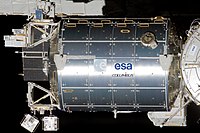
Photo from wikipedia
The Atmosphere-Space Interactions Monitor (ASIM) is an instrument suite on the International Space Station (ISS) for measurements of lightning, Transient Luminous Events (TLEs) and Terrestrial Gamma-ray Flashes (TGFs). Developed in… Click to show full abstract
The Atmosphere-Space Interactions Monitor (ASIM) is an instrument suite on the International Space Station (ISS) for measurements of lightning, Transient Luminous Events (TLEs) and Terrestrial Gamma-ray Flashes (TGFs). Developed in the framework of the European Space Agency (ESA), it was launched April 2, 2018 on the SpaceX CRS-14 flight to the ISS. ASIM was mounted on an external platform of ESA’s Columbus module eleven days later and is planned to take measurements during minimum 3 years. The instruments are an x- and gamma-ray monitor measuring photons from 15 keV to 20 MeV, and an array of three photometers and two cameras measuring in bands at: 180–250 nm, 337 nm and 777.4 nm. Additional objectives that can be addressed with the instruments relate to space physics like aurorae and meteors, and to Earth observation such as dust- and aerosol effects on cloud electrification. The paper describes the scientific objectives of the ASIM mission, the instruments, the mission architecture and the international collaboration supported by the ASIM Science Data Centre. ASIM is the first space mission with a comprehensive suite of instruments designed to measure TLEs and TGFs. Two companion papers describe the instruments in more detail (Østgaard et al. in Space Sci. Rev., 2019; Chanrion et al. in Space Sci. Rev., 2019).
Journal Title: Space Science Reviews
Year Published: 2019
Link to full text (if available)
Share on Social Media: Sign Up to like & get
recommendations!